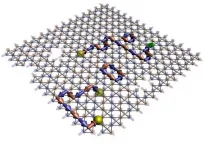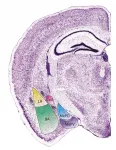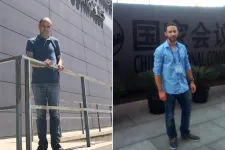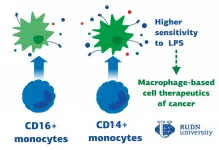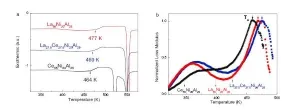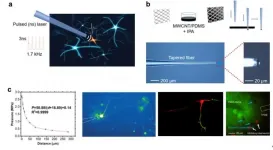(Press-News.org) LOS ALAMOS, N.M., July 15, 2021-- Using a D-Wave quantum-annealing computer as a testbed, scientists at Los Alamos National Laboratory have shown that it is possible to isolate so-called emergent magnetic monopoles, a class of quasiparticles, creating a new approach to developing "materials by design."
"We wanted to study emergent magnetic monopoles by exploiting the collective dynamics of qubits," said Cristiano Nisoli, a lead Los Alamos author of the study. "Magnetic monopoles, as elementary particles with only one magnetic pole, have been hypothesized by many, and famously by Dirac, but have proved elusive so far."
They realized an artificial spin ice by using the superconducting qubits of the quantum machine as a magnetic building block. Generating magnetic materials with exotic properties in this way is ground-breaking in many ways. Their process used Gauss's law to trap monopoles, allowing the scientists to observe their quantum-activated dynamics and their mutual interaction. This work demonstrates unambiguously that magnetic monopoles not only can emerge from an underlying spin structure, but can be controlled, isolated and studied precisely.
"It was shown in the last decade or so that monopoles can emerge as quasiparticles to describe the excitation spin ices of various geometries. Previously, the National High Magnetic Field Laboratory's Pulsed Field Facility here at Los Alamos was able to 'listen' to monopole noise in artificial spin ices. And now, utilizing a D-Wave quantum annealing system, we have enough control to actually trap one or more of these particles and study them individually. We saw them walking around, getting pinned down, and being created and annihilated in pairs of opposite magnetic charge. And we could thus confirm our quantitative theoretical predictions, that they interact and in fact screen each other," said Nisoli.
"D-Wave's processors are designed to excel in optimization, but can also be used as quantum simulators. By programming the desired interactions of our magnetic material into D-Wave's qubits, we can perform experiments that are otherwise extremely difficult," said Andrew King, director of Performance Research at D-Wave and an author on the paper. "This collaborative, proof-of-principle work demonstrates new experimental capabilities, improving the power and versatility of artificial spin ice studies. The ability to programmatically manipulate emergent quasiparticles may become a key aspect to materials engineering and even topological quantum computing; we hope it will be foundational for future research."
Nisoli added, "We have only scratched the surface of this approach. Previous artificial spin ice systems were realized with nanomagnets, and they obeyed classical physics. This realization is instead fully quantum. To avoid leapfrogging we concentrated so far on a quasi-classical study, but in the future, we can really crank up those quantum fluctuations, and investigate very timely issues of decoherence, memory, quantum information, and topological order, with significant technological implications."
"These results also have technological consequences particularly relevant to DOE and Los Alamos, specifically in the idea of materials-by-design, to produce future nanomagnets that might show advanced and desirable functionality for sensing and computation. Monopoles, as binary information carriers, can be relevant to spintronics. They also contribute significantly to Los Alamos D-Wave investments," noted Alejandro Lopez- Bezanilla of Los Alamos, who works on the D-Wave processor and assembled the team.
Nisoli, moreover, suggests that beside fruitful applications, these results could perhaps also provide food for thought to fundamental physics.
"Our fundamental theories of particles are parametrized models. One wonders: what is a particle? We show here experimentally that not only particles but also their long-range interactions can be a higher-level description of a very simple underlying structure, one only coupled at nearest-neighbors. Could even 'real' particles and interactions that we consider fundamental, such as leptons and quarks, instead be construed as an emergent, higher-level description of a more complex lower-level binary substratum, much like our monopoles emerging from a bunch of qubits?"
INFORMATION:
The paper: Qubit Spin Ice, Science First Release (online), 15 July, 2021. Andrew King, Cristiano Nisoli, Edward D. Dahl, Gabriel Poulin-Lamarre, Alejandro Lopez-Bezanilla. DOI 10.1126/science.abe2824
The funding: This project was funded under a Los Alamos National Laboratory Directed Research grant.
About D-Wave Systems Inc.
D-Wave is the leader in the development and delivery of quantum computing systems, software and services and is the world's first commercial supplier of quantum computers. Our mission is to unlock the power of quantum computing for the world. We do this by delivering customer value with practical quantum applications for problems as diverse as logistics, artificial intelligence, materials sciences, drug discovery, scheduling, cybersecurity, fault detection, and financial modeling. D-Wave's systems are being used by some of the world's most advanced organizations, including NEC, Volkswagen, DENSO, Lockheed Martin, USRA, USC, and Los Alamos National Laboratory. With headquarters near Vancouver, Canada, D-Wave's US operations are based in Palo Alto, CA. D-Wave has a blue-chip investor base including PSP Investments, Goldman Sachs, BDC Capital, NEC Corp., and In-Q-Tel. For more information, visit: http://www.dwavesys.com.
About Los Alamos National Laboratory
Los Alamos National Laboratory, a multidisciplinary research institution engaged in strategic science on behalf of national security, is managed by Triad, a public service oriented, national security science organization equally owned by its three founding members: Battelle Memorial Institute (Battelle), the Texas A&M University System (TAMUS), and the Regents of the University of California (UC) for the Department of Energy's National Nuclear Security Administration.
Los Alamos enhances national security by ensuring the safety and reliability of the U.S. nuclear stockpile, developing technologies to reduce threats from weapons of mass destruction, and solving problems related to energy, environment, infrastructure, health, and global security concerns.
LA-UR-21-26585
Great leaps in science and technology have been propelled by recent advances in seeing fast evolving physical phenomena, as they happen. Femtosecond lasers from the infrared to the X-ray region have enabled us to 'watch', in real time, atoms dance in molecules and solids on femtosecond and picosecond timescales. Watching such fascinating motions not just in real time but at the spatial locations where they happen, is a bigger challenge.
It is precisely this advance that has been made by a team of researchers at the Tata Institute of Fundamental Research, Mumbai, York University and the Rutherford Appleton Laboratories, UK [1]. They exploded a solid surface with an ultrahigh ...
Fear is an important reaction that warns and protects us from danger. But when fear responses are out of control, this can lead to persistent fears and anxiety disorders. In Europe, about 15 percent of the population is affected by anxiety disorders. Existing therapies remain largely unspecific or are not generally effective, because the detailed neurobiological understanding of these disorders is lacking.
What was known so far is that distinct nerve cells interact together to regulate fear responses by promoting or suppressing them. Different circuits of nerve cells are involved in this process. A kind of "tug-of-war" takes place, with one brain circuit ...
A new way of producing coherent light in the ultra-violet spectral region, which points the way to developing brilliant table-top x-ray sources, has been produced in research led at the University of Strathclyde.
The scientists have developed a type of ultra-short wavelength coherent light source that does not require laser action to produce coherence. Common electron-beam based light sources, known as fourth-generation light sources, are based on the free-electron laser (FEL), which uses an undulator to convert electron beam energy into X-rays.
Coherent light sources are powerful tools that enable research in many areas of medicine, biology, material sciences, chemistry and physics.
This new way of producing coherent radiation could revolutionise light sources, as it would ...
In the field of industrial engineering, using simulations to model, predict and even optimise the response of a system or device is widespread, as it is less expensive and less complex -and, sometimes, less dangerous- than fabricating and testing several prototypes.
This type of simulation studies uses numerical methods that, depending on the problem to be addressed -for example, reducing the aerodynamic forces of an aircraft by changing its shape or using the minimum possible amount of material on elements under loading without breaking- require the simulation of a wide variety of possible combinational cases, which entails high computational costs.
The researchers from the School of Industrial Engineering of the University of Malaga Francisco Javier Granados Ortiz ...
Neuro-evolutionary robotics is an attractive approach to realize collective behaviors for swarms of robots. Despite the large number of studies that have been devoted to it and although many methods and ideas have been proposed, empirical evaluations and comparative analyses are rare.
A publication in the journal Nature Communications, led by Mauro Birattari and his team at the research center IRIDIA, École Polytechnique de Bruxelles, Université Libre de Bruxelles, compares some of the most popular and advanced neuro-evolutionary methods for offline design of robot swarms.
"Concretely, these ...
RUDN University biologists discovered the way how macrophages (the cells of the "first line" immune response) respond to inflammation and identified how the immune response depends on their origin. It turned out that when exposed to an inflammatory stimulus, two opposing mechanisms are activated in macrophages simultaneously -- inducing and inhibiting inflammation. These data can potentially be useful in the treatment of cancer, as targeted activation of macrophages will strengthen the immune response of the organism in the fight against a tumor. The results were published in the journal Biomedicine & Pharmacotherapy.
Macrophages are the cells responsible for phagocytosis -- they capture bacteria, the dead cells remains ...
A collaborative group from Tohoku University and Johns Hopkins University have provided valuable insights into the glass transition.
When a liquid is cooled rapidly, it gains viscosity and eventually becomes a rigid solid glass. The point at which it does so is known as the glass transition.
But the exact physics behind the glass transition, and the nature of glass in general, still pose many questions for scientists.
Metallic Glasses (MGs) are highly sought after since they combine the flexibility of plastic with the strength of steel. They are amorphous materials with a disordered atomic structure and exhibit unique and divergent thermodynamic ...
Neuromodulation at high spatial resolution has been an invaluable approach for treating neurological diseases and advancing fundamental knowledge in the field of neuroscience, as firing of a small population or even single neurons can specifically alter animal behavior or brain state. Optogenetics is a powerful method capable of modulating population neural activity in rodents, yet its requirement for viral transfection limits its applications in nonhuman primates and humans. As a rapidly growing modality, focused ultrasound has been harnessed in a myriad of brain neuromodulation applications. However, conventional piezo-based transducers offer a spatial resolution of several millimeters. It is also challenging ...
JULY 15, 2021, NEW YORK - A Ludwig Cancer Research study has found that inducing random chromosome instability (CIN) events in mice for as little as one week is enough to trigger harmful chromosomal patterns in cells that spur the formation of tumors.
"We show that you don't need chronic, lifelong chromosomal mistakes to produce tumorigenesis at a quite respectable frequency," said Don Cleveland, Member of the Ludwig Institute for Cancer Research, San Diego, who led the study with Floris Foijer of the University of Groningen, in The Netherlands. "A very transient exposure would likely be sufficient to drive a very substantial increase in tumorigenesis."
The finding, detailed this week in the journal END ...
Washington, DC / New Delhi, India - Researchers at CDDEP recently published 'Improving vaccination coverage and timeliness through periodic intensification of routine immunization: evidence from Mission Indradhanush' where they evaluated the performance of India's Mission Indradhanush (MI) child vaccination campaign -- a periodic intensification of the routine immunization program.
Each year, 1.2 million Indian children die, accounting for a fifth of global under-5 deaths. Over 400,000 of these deaths are from vaccine-preventable diseases. An estimated 38% of Indian children under the age of two years were not-fully-immunized in 2016. Additionally, vaccinated children received 23%-35% of the doses of polio, diphtheria-pertussis-tetanus ...
